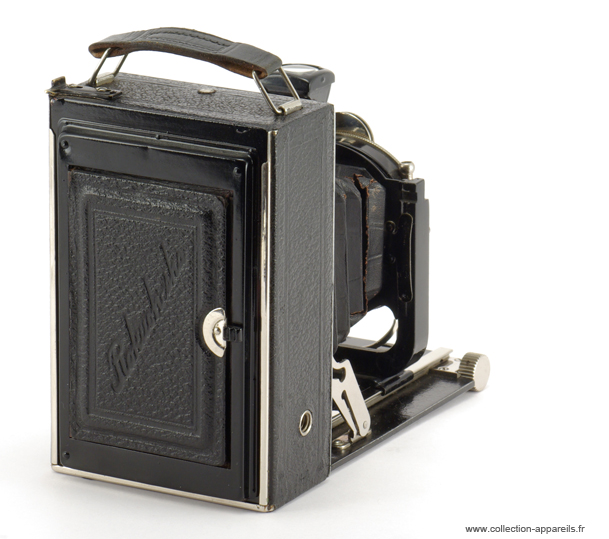|
Konica Idea (Showa 8) |
Manufactured or assembled in Japan from 1933 to (After) 1933.
Index of rarity in France: Rare (among non-specialized garage sales)
Inventory number: 7083
See the complete technical specifications
Chronology of cameras Konica
Le Sugiyama (the collector's guide to japanese cameras, ISBN4-257-03187-5) distingue deux types d'Idea (Showa 8), différents par leur système de mise au point : Idea Hand Camera (Showa 8) pour le modèle avec levier en arc de cercle à main droite, et Idea (Showa 8) pour celui offrant un demi-tirage avec mise au point par molette comme ici.
Mais au fait : pourquoi Showa 8 ? Comme il a déjà existé une chambre appelée Idea Hand Camera sortie en 1930 on désigne le nouveau modèle de 1933 par son année de sortie, mais à la mode japonaise : la huitième année de l'ère Showa, soit le règne de Hiro Hito, 124° empereur du Japon ! Selon la correspondance officielle il s'agit donc de 1933, 1926 étant en même temps la quinzième année du règne de Taisho et la première de celui de Showa.
Il s'agit donc d'une évolution de l'Idea Hand Camera de 1930, légèrement plus compacte à format égal. Le tirage, sans être un réel double tirage, est plus long que sur son prédécesseur, lequel est limité par son levier de mise au point en arc de cercle. Ici, on peut obtenir presque 4 cm d'allongement en théorie, l'état du soufflet plus de 80 ans plus tard ne l'autorisant plus en pratique...
L'amélioration majeure vient sans contestation du décentrement vertical, absent sur le modèle de 1930. Le nom du modèle (Idea) est gravé, réhaussé de blanc, à l'intérieur de l'abattant au centre. Celui-ci est articulé avec un ressort dans la charnière, et sort donc presque seul dès qu'on pousse le traditionnel bouton sous la poignée. Les deux prises de doigts en triangle sont très agréables pour amener la façade jusqu'au cran correspondant à l'infini; une mise au point rapprochée se fait ensuite avec la molette à main droite, mais il faut penser à libérer l'index en appuyant sur la plaquette des distances. Un reproche pourra être fait concernant l'absence de blocage de la console sur le rail, aucun ressort ni verrou n'étant prévu...
Le couple objectif / obturateur monté ici est purement japonais, mais pas totalement maison : l'objectif est bien dessiné par Rokuoh-sha (la branche "fabrication" de Konica), mais sans doute fabriqué par Asahi Kogaku. L'obturateur Durax, successeur du Zeus, était conçu et fabriqué par la firme elle-même. D'autres combinaisons ont été proposées, toutes japono-japonaises.
Sur le côté de la chambre est rivetée une plaque donnant les limites de profondeur de champ en fonction des ouvertures et du réglage de la mise au point.
Cet exemplaire, dans un état remarquable, a été trouvé seul, sans étui ni accessoire autre que le dépoli. Malheureusement, il lui manque, pour une raison inconnue, la totalité du viseur à cadre. Un ancien propriétaire, qui ne l'utilisait peut-être pas, l'aurait-il démonté ?
Autre regret : le soufflet, pourtant visuellement très beau, est claqué au niveau du premier pli, juste derrière la console.
L'appareil a heureusement conservé ses deux écrous de pied, au petit pas !


History
1873 Establishment of the Konishi-ya company. Initial implementation of photographic and lithographic materials.
1876 Relocation to Tokyo. The company is renamed Konishi Honten.
1882 Three factories are established in Tokyo, producing photographic equipment, coated paper, and lithography equipment.
1897 Introduction of the first cinematographic cameras in Japan, enabling the production of Japanese films.
1902 Establishment of a new factory in Tokyo dedicated to the production of photographic plates and papers. This factory is considered the birthplace of the Japanese photographic industry.
1903 The first photosensitive paper produced in Japan, Sakura Hakkin type paper, and the Cherry camera are introduced to the market.
1909 Opening of the Osaka Agency. Introduction of the LiIy camera.
1919 Consolidation of factories in Tokyo, forming Japan's first modern photographic organization.
1921 This organization becomes the Konishiroku Honten Company (Honten = headquarters).
1925 Introduction of Pearlette cameras.
1929 Launch of Sakura films (Sakura = Japanese cherry blossom).
1933 Expansion of the headquarters.
1936 The company becomes Konishiroku Co., Ltd. Opening of an agency in Hino, and relocation of the Sensitive Materials Production Division.
1938 Introduction of the Semipearl camera.
1940 Announcement of the production of the first Japanese color film, Sakura Natural Color Film.
1943 The company adopts its current name, Konishiroku Photo Industry Co., Ltd., and the factories are renamed.
1944 Merger with Showa Photo Industries Co., Ltd., adding the Odawara and Koyama factories to the company.
1945 End of the war, leading to a chaotic economic situation. A major reorganization is undertaken to enable the company to survive this tumultuous period.
1948 Sale of the first KONICA-branded cameras and resumption of exports.
1963 Inauguration of the large factory for the production of photographic equipment.
1967 Introduction of the world's great innovation, the SAKURACOLOR N-100, along with the world's first automatic reflex, the KONICA AUTO-REFLEX.
1968 The first automatic reflex camera (EE) incorporates through-the-lens (TTL) metering: it becomes the KONICA AUTOREFLEX T. Production of the first Japanese 24 x 36 compact rangefinder camera, the KONICA C35, in the same year.
1969 Development by Konishiroku of the world's first compact holographic camera.
1970 Start of the sale of U-Bix electrostatic dry photocopying machines. Introduction of SAKURA High Resolution Plate, ultra-fine grain, high-resolution sensitive material essential for Integrated Circuit manufacturing.
1971 Introduction of the new SAKURACOLOR. Commencement of U-Bix MARK I export.
1973 Celebration of the 100th anniversary of the company. Adoption of the new logo. Departure for a new century with renewed enthusiasm.
Interesting links or bibliography :
Add a link or element of bibliography, a picture taken with this camera, a picture of box or an ads about this camera
Your photos taken with the same camera:
Cameras from Ebay France (Konica) (Uploaded each 3 hours)
 Appareil De Photo Konica 30,00 euros Finira le 04-05-2024 à 15:07:46 |  Konica C35 EFP Lens 38mm F4 Appareil photo argentique - Non Testé - Pour Pièces 1,00 euros Finira le 04-05-2024 à 16:43:13 |  Appareil photo Compact * Konica BM-S 248Z * argentique vintage 24-48 mm 27,50 euros Finira le 04-05-2024 à 16:22:14 |  APPAREIL PHOTO KONICA EF-88 non testé en l'etat 10,00 euros Finira le 06-05-2024 à 11:42:36 |








